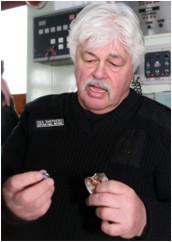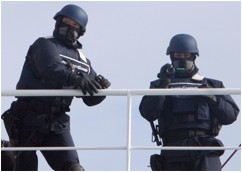
 07/03/2008
07/03/2008
At 1545 hours (0445 GMT), a clash between the crew of the Sea Shepherd vessel Steve Irwin and the Japanese whaling ship Nisshin Maru turned violent when the Japanese Coast Guard began to throw flash grenades at the crew of the Steve Irwin.
Captain Paul Watson was struck by a bullet in the chest. Fortunately, the bullet was stopped by his Kevlar vest. The bullet struck just above the heart and mangled Captain Watson’s anti-poaching badge, which was worn on his sweater underneath the Kevlar vest.
Dr. David Page was videotaped prying the bullet from Captain Watson’s Kevlar vest. “You have been hit by a bullet,” he said.
The Kevlar vest and anti-poaching badge effectively saved Captain Watson’s life.
Additional injuries were sustained by crewmembers Ashley Dunn and Ralph Lowe. Dunn, 35, from Launceston, Australia suffered a hip injury when he tried to get out of the way of the exploding grenades. Lowe, 33, from Melbourne, Australia received bruises to his back when one of the flash grenades exploded behind him.
The Japanese Coast Guard was retaliating against Sea Shepherd crewmembers for tossing rotten butter onto the decks to discourage their illegal whaling activities. The clash came after a week long pursuit by the Steve Irwin of the Nisshin Maru, in an effort to stop illegal whaling activities in the Southern Ocean Whale Sanctuary.
Earlier in the day at 0800 hours (1900 GMT), the Steve Irwin had ordered the Nisshin Maru to leave French territorial waters. The Japanese whaler complied and turned around, heading back west into Australian waters.
The confrontation occurred inside the Australian Territorial Zone at the position of 63 Degrees, 41 Minutes South and 133 Degrees, 27 Minutes East.
Japanese Scramble to Spin Shooting Story
In the aftermath of a confrontation between the crew of the whaling ship Nisshin Maru and the crew of the Sea Shepherd ship Steve Irwin, the Japanese public relations flacks are working overtime to get the spin right.
First, they admitted that warning shots were fired, then they corrected themselves and said that only flash grenades were fired at the crew of the Steve Irwin. Then they changed the story again and described the flash grenades as “warning balls.” By tomorrow morning, they may have it spun it again and may be describing them as “marshmallows.”
The Japanese Coast Guard and the Japanese Fisheries Agency have stated to the media that the devices were flash grenades and that warning shots were fired. Only the Institute for Cetacean Research is denying that warning shots were fired and describing the flash grenades as “warning balls.”
“I think the video tells the story,” said Sea Shepherd volunteer Laurens De Groot, a former police officer from Rotterdam. “I’m familiar with the devices thrown. They are the type of flash grenade that specially trained SWAT teams used to combat armed and dangerous criminals.”
The Japanese claim that Captain Paul Watson is lying about being shot was expected. When Giles Lane and Benjamin Potts were tied to the mast of the Yusshin Maru No. 2, the Institute for Cetacean Research claimed it was a lie until the video images were released.
Dr. David Page, the ship’s medical officer, has examined and verified that there were three injuries sustained, all severe bruises. Ralph Lowe from Melbourne was bruised on the back by an exploding flash grenade, and Animal Planet cameraman Ashley Dunn from Launceston, Tasmania injured his hip while trying to avoid a flash grenade. Captain Watson has a large bruise and a cut on the upper left side of his chest.
Dr. Page pried a bullet from Captain Watson’s Kevlar vest and examined the bruise where the bullet impacted. Watson’s Sea Shepherd anti-poaching badge took up some of the force of the impact, but it also cut the skin beneath after it was mangled by the bullet.
Japan claims there were only two Coast Guard officers on the Nisshin Maru, but Sea Shepherd photos and videos clearly show at least four uniformed Coast Guardsmen.
Japanese Chief Cabinet Secretary Nobutaka Machimura was quoted as saying to the media, “Is it all right to hurt humans in order to protect whales? I think whales are cute and important creatures, but even so, hurting humans is unforgivable.”
That is quite the spin–accusing Sea Shepherd crew, who did not injure anyone, of hurting humans after Japanese whalers and the Coast Guard deliberately injured human beings to protect an illegal whaling operation.
The Japanese Coast Guard admitted to the media only a few days ago that its officers were armed with rifles and sidearms. Now they are denying they have rifles.
The Japanese keep changing their story.
The most important fact remains that the Japanese whaling fleet is illegally killing endangered whales in a whale sanctuary in violation of international law and an Australian Federal Court order.
